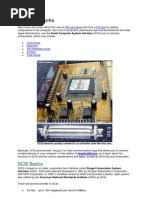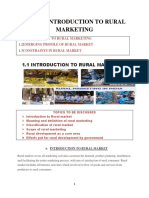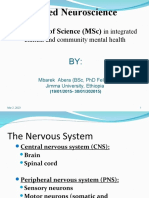100%(1)100% found this document useful (1 vote)
2K viewsTopic: Howard Sheth Model
The Howard-Sheth model of buying behavior attempts to explain the complexity of consumer decision making when information is incomplete. It suggests three levels of decision making: extensive problem solving when a consumer has no information; limited problem solving when a consumer has some knowledge; and habitual response behavior when a consumer is very familiar with brands. The model includes four sets of variables that influence decision making: inputs like information sources; perceptual and learning constructs regarding how consumers understand information; outputs reflecting consumers' responses; and exogenous variables such as importance of purchase and time pressure.
Uploaded by
Phaniraj LenkalapallyCopyright
© Attribution Non-Commercial (BY-NC)
Available Formats
Download as PPT, PDF, TXT or read online on Scribd
100%(1)100% found this document useful (1 vote)
2K viewsTopic: Howard Sheth Model
The Howard-Sheth model of buying behavior attempts to explain the complexity of consumer decision making when information is incomplete. It suggests three levels of decision making: extensive problem solving when a consumer has no information; limited problem solving when a consumer has some knowledge; and habitual response behavior when a consumer is very familiar with brands. The model includes four sets of variables that influence decision making: inputs like information sources; perceptual and learning constructs regarding how consumers understand information; outputs reflecting consumers' responses; and exogenous variables such as importance of purchase and time pressure.
Uploaded by
Phaniraj LenkalapallyCopyright
© Attribution Non-Commercial (BY-NC)
Available Formats
Download as PPT, PDF, TXT or read online on Scribd
You are on page 1/ 12
Topic:-Howard-sheth model
Steps in consumer decision making model:-
1) Need recognition
2) search for information
3) Alternatives
4) Evaluation
5) Purchase
6) Post purchase evaluation
There are three important models which explain
consumer decision making
Howard-Sheth model of buying behavior
The Nicosia model.
The Engel-Blackwell-Miniard (EBM) model.
The Howard-Sheth model of buying behavior
attempts to explain the complexity of the
consumer decision making process in case of
incomplete information.
This model suggests three levels of decision
making
A) Extensive problem solving.
B) limited problem solving.
C) Habitual response behavior.
At this level the consumer does not have any
basic information or knowledge about the brand
and he does not have any preferences for any
product.
In this situation, the consumer will seek
information about all the different brands in the
market before purchasing.
This situation exists for consumers who have
little knowledge about the market, or partial
knowledge about what they want to purchase.
In order to arrive at a brand preference some
comparative brand information is sought.
In this level the consumer knows very well about the
different brands and he can differentiate between the
different characteristics of each product.
According to the Howard-Sheth model there are four major
sets of variables:
Inputs.
Perceptual and Learning Constructs
Outputs
Exogenous(External) variables
INPUTS:- These input variables consist of three
distinct types of information sources in the
consumer’s environment.
Significative:- Information furnishes physical brand
characteristics such as
Quality,price,distinctive,service,availability.
Symbolic:-verbal or visual product characteristics
such as Quality,price,distinctive,service,availability.
consumer’s social environment:- family, reference
group, and social class.
Perceptual and Learning Constructs:-
It deals with the
psychological variables involved when the
consumer is making a decision.
How the consumer receives and understands the
information from the input s.
consumers goals, information about brands,
criteria for evaluation alternatives, preferences
and buying intentions are all included.
Outputs:-
The outputs are the results of the perceptual and learning
variables and how the consumers will response to these variables .
Exogenous(External) variables:-
some relevant exogenous variables include
The importance of the purchase,
Consumer personality traits,
Religion, and
Time pressure.
You might also like
- The 100 Best Self Help Books of All Time HNo ratings yetThe 100 Best Self Help Books of All Time H50 pages
- Presentation On Evaluative Criteria and Decision RulesNo ratings yetPresentation On Evaluative Criteria and Decision Rules9 pages
- Nicosia Model: Nicosia Model Is A Structural Model of The Purchase Decision100% (1)Nicosia Model: Nicosia Model Is A Structural Model of The Purchase Decision13 pages
- Life Style Profiles of Social Class: Presented ByNo ratings yetLife Style Profiles of Social Class: Presented By18 pages
- Buying Decision Process in Rural Marketing PDFNo ratings yetBuying Decision Process in Rural Marketing PDF14 pages
- Integration of Sales and Distribution Strategies Final 200350% (2)Integration of Sales and Distribution Strategies Final 200324 pages
- Individual Determinants of Consumer Behaviour100% (3)Individual Determinants of Consumer Behaviour21 pages
- Social Class Mobility and Affluent and Non-Affluent Consumer100% (1)Social Class Mobility and Affluent and Non-Affluent Consumer19 pages
- Consumer Behaviour - Influence of Culture and Subculture90% (10)Consumer Behaviour - Influence of Culture and Subculture15 pages
- Consumer Behaviour Impact of Branding OnNo ratings yetConsumer Behaviour Impact of Branding On19 pages
- Sales Related Marketing Policies - Product PoliciesNo ratings yetSales Related Marketing Policies - Product Policies10 pages
- Organizing Personal Selling in Rural Marketing100% (1)Organizing Personal Selling in Rural Marketing16 pages
- Chapter 8 Atmospherics and Retail Space-Retail Management100% (2)Chapter 8 Atmospherics and Retail Space-Retail Management27 pages
- UNIT-4: Functions and Importance of Marketing ChannelsNo ratings yetUNIT-4: Functions and Importance of Marketing Channels39 pages
- Buy Grid Framework & Buying Situations: SAKSHI JAIN (FB09108) Pankaj Soni (Fb09098100% (2)Buy Grid Framework & Buying Situations: SAKSHI JAIN (FB09108) Pankaj Soni (Fb0909821 pages
- Howard and Sheth Model of Consumer BehaviourNo ratings yetHoward and Sheth Model of Consumer Behaviour2 pages
- Models of Consumer Behavior: - Engel, Blackwell and Miniard (EBM) - Howard Sheth Model of Buying BehaviourNo ratings yetModels of Consumer Behavior: - Engel, Blackwell and Miniard (EBM) - Howard Sheth Model of Buying Behaviour20 pages
- "An Insight Into Portfolio Management With Relevance To Customer Expectations100% (1)"An Insight Into Portfolio Management With Relevance To Customer Expectations73 pages
- Schizophrenia Spectrum and Other Psychotic DisordersNo ratings yetSchizophrenia Spectrum and Other Psychotic Disorders8 pages
- PDF Andy Clark and His Critics Matteo Colombo download100% (5)PDF Andy Clark and His Critics Matteo Colombo download55 pages
- 15. Therapeutic Effects & Uses of Faradic CurrentNo ratings yet15. Therapeutic Effects & Uses of Faradic Current21 pages
- Mubarek Aplied Neuroscience PPT Lecture NoteNo ratings yetMubarek Aplied Neuroscience PPT Lecture Note50 pages
- Yulistia Rahmi Putri 19040001 - Quiz Cognitive DevelopmentNo ratings yetYulistia Rahmi Putri 19040001 - Quiz Cognitive Development3 pages
- Clinical Rehabilitation: Pavel Kolář Et AlNo ratings yetClinical Rehabilitation: Pavel Kolář Et Al24 pages
- What Is Reality Testing and Why Is It ImportantNo ratings yetWhat Is Reality Testing and Why Is It Important5 pages
- Presentation On Evaluative Criteria and Decision RulesPresentation On Evaluative Criteria and Decision Rules
- Nicosia Model: Nicosia Model Is A Structural Model of The Purchase DecisionNicosia Model: Nicosia Model Is A Structural Model of The Purchase Decision
- Integration of Sales and Distribution Strategies Final 2003Integration of Sales and Distribution Strategies Final 2003
- Social Class Mobility and Affluent and Non-Affluent ConsumerSocial Class Mobility and Affluent and Non-Affluent Consumer
- Consumer Behaviour - Influence of Culture and SubcultureConsumer Behaviour - Influence of Culture and Subculture
- Sales Related Marketing Policies - Product PoliciesSales Related Marketing Policies - Product Policies
- Chapter 8 Atmospherics and Retail Space-Retail ManagementChapter 8 Atmospherics and Retail Space-Retail Management
- UNIT-4: Functions and Importance of Marketing ChannelsUNIT-4: Functions and Importance of Marketing Channels
- Buy Grid Framework & Buying Situations: SAKSHI JAIN (FB09108) Pankaj Soni (Fb09098Buy Grid Framework & Buying Situations: SAKSHI JAIN (FB09108) Pankaj Soni (Fb09098
- Models of Consumer Behavior: - Engel, Blackwell and Miniard (EBM) - Howard Sheth Model of Buying BehaviourModels of Consumer Behavior: - Engel, Blackwell and Miniard (EBM) - Howard Sheth Model of Buying Behaviour
- "An Insight Into Portfolio Management With Relevance To Customer Expectations"An Insight Into Portfolio Management With Relevance To Customer Expectations
- Schizophrenia Spectrum and Other Psychotic DisordersSchizophrenia Spectrum and Other Psychotic Disorders
- PDF Andy Clark and His Critics Matteo Colombo downloadPDF Andy Clark and His Critics Matteo Colombo download
- Yulistia Rahmi Putri 19040001 - Quiz Cognitive DevelopmentYulistia Rahmi Putri 19040001 - Quiz Cognitive Development















































































































